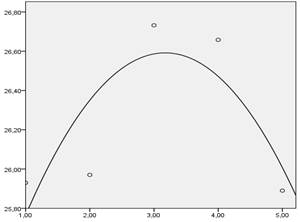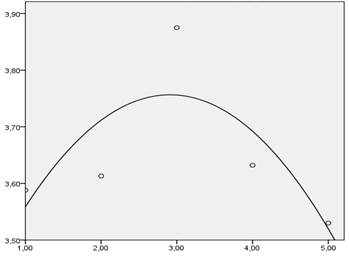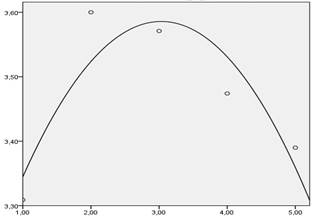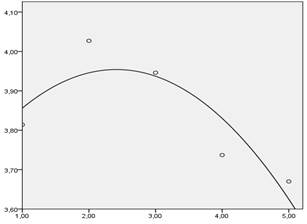Abstract
Personality psychological security has an immediate linkage with the place of the person’s residence, and the environment greatly affects both his behavior and development. The study aimed to examine characteristics of personality psychological security in residents of administrative and territorial units with different populations. The study involved citizens of 48 territories of the Sverdlovsk region. The methodical tools exploited in the work embraced techniques to identify both conscious and unconscious assessments of the respondents. The study revealed that the linkage between personality psychological security and the number of people living in the given territory has a non-monotonous, curvilinear character. The highest psychological security is typical of large cities’ residents, the lowest – of small towns and a city of over a million inhabitants. Analyzing the link between particular aspects of personality psychological security and the number of residents in one administrative-and-territorial unit, the authors found the same regularity: the person’s need for law and order, events’ predictability, and stability has a quadratic-type bond with the population of the territory in question. Therefore, from the perspective of psychological security, inhabitants of a million-plus city and towns find themselves in less favorable conditions. And the very perceptions of security differ in the residents of these two types of administrative and territorial units. Mega-city dwellers tie up security with reliability, freedom, and comfort. Towns’ residents maintain more traditional perceptions of security; they associate it with the order, institutions (army, the police) and family support.
Keywords: Psychological securitypsychology of environmentsocial representations
Introduction
Today, more the a half of the world population live in cities, and this tendency to urbanization is continuing. Life in a city is linked to the increase in population’ density, noise and the environmental pollution, on the one hand, and a growing availability of medical help and other services, on the other. Psychological security is a state of personality when the individual can satisfy his/her basic needs for self-preservation and be aware of his/her own (psychological) security in society (Zotova, 2011, p. 134). Personality psychological security has an immediate linkage with the place of the person’s residence, and the environment greatly affects both his behavior and development (Dontsov et al., 2019, p. 74). Man is permanently exposed to environmental impacts to a different degree, and depending on a multitude of factors he experiences various sensations thanks to which he can ether develop, or have arrested development due to anxiety, fears, stress, etc (Gold, 1990). From birth, people interact with their physical and social environment, which results in a particular vision of themselves in the world around them (Oswald & Wahl, 2003).
The risk of some serious mental diseases (for instance, anxiety, psychotic disorders, and mood disorders) is usually higher in cities. Research on anxiety including PTSD found higher indicators in the city districts in several countries of Latin America and Asia (Phillips et al., 2009; Prina et al., 2011; Silove et al., 2014; Sharifi et al., 2015), schizophrenia in large cities of China (Long et al., 2014), and urban areas of Germany (Frick et al., 2013; Jacobi et al., 2014). Danish researchers found that the risk of schizophrenia was more than doubled in people who had spent their first 15 years in cities compared to those who grew up in the countryside (Abbott, 2011; Galea et al., 2011; Heinz et al., 2013; Haddad et al., 2015; Lederbogen et al., 2011; Mortensen et al., 1999; March et al., 2008; Pedersen & Mortensen, 2001; van Os et al., 2010; Vassos et al., 2012). By contrast, rural inhabitants were more likely to be alcohol addicted than citizens, as shown in the Chinese research (Phillips et al., 2009). The main reason for lower psychological security in big cities is the lack of social links and cohesion in the areas.
In its turn, the place of residence characterized by higher social support and collective effectiveness can lower the perceived stress through the support of neighbors (Ahern & Galea, 2011; Bertotti et al., 2013). Besides, social aid protects from disorders associated with the intake of psychoactive substances, or the attempted suicide (Fone et al., 2014; Maimon et al., 2010; WHO, 2014).
Although the life in the city has many advantages such as availability of medical health, more jobs, higher salaries, and diverse cultural life, some research showed that city life causes stress due to noise, pollution, and lifestyle (Kennedy & Adolphs, 2011; Lederbogen et al., 2011). Several scholars also revealed that such factors as differences in social support (on the part of family or friends), stressful events and family responsibility between urban and rural areas can also impact psychological security on the quality of their life (Amato, 1993; Fuligni & Zhang, 2004; Hofferth & Iceland, 1998; Lederbogen et al., 2011; Paykel et al., 2000). Moreover, rural and urban environments differ in their natural resources, and urban territories, as a rule, have fewer green restorative zones necessary for people’s health and wellbeing (Bernam et al., 2012; De Vries et al., 2003). One more study confirming the linkage between the environment and wellbeing demonstrated that unlike a walk down ‘grey, construction areas’, a stroll through the city woods have a positive impact on both cognitive functions and mood improvement (Bernam et al., 2012).
Problem Statement
One of the key characteristics of modern society development is rapidly growing cities and cities’ populations, the formation of conurbations. It inevitably leads to the intensification of information exchange and the acceleration of dynamic processes. Environmental factors influence the person’s emotional state, and it is emotions through which a sense of security/insecurity is shaped. In the city, the individual faces a variety of threats to his psychological security. First of all, it is a high density of population, a high level of transport development, geographical fragmentation, and information overload due to the flourishing media. All this allows for assuming that the residents of different territorial areas will assess their psychological security taking into consideration the size of the administrative-and territorial areas they live in.
Research Questions
The following issues were to be resolved for the implementation of the study.
1. Is there any link and of what kind between psychological security of the individual and the number of people living in the area of his residence?
2. Do the social representations of security differ in inhabitants living in the areas with different sizes of the population?
Purpose of the Study
The survey aimed to research characteristics of psychological security in residents of the administrative-and territorial areas with different sizes of the population.
The realization of the aim required addressing the following tasks:
1. To single out the presence /absence of the link between psychological security of the individual and the number of the population of his place of residence.
2. To define the linkage of the substantive aspects of the person’s psychological security and the size of the population of his territorial area.
3. To identify the structure of the security perceptions in residents of the administrative-and territorial areas with different sizes of the population.
4. To reveal differences in the structure and content of security perceptions in residents of the administrative-and territorial areas with different sizes of the population.
Research Methods
Subjects
The sampling consisted of inhabitants representing 48 administrative-and territorial areas of the Sverdlovsk region. To make the sample of each territorial unit representative and exact in reflecting the general population – the structure of the population according to gender and age – each area frame sampling was defined based on the analysis of demographic indicators of these territorial units. The indicators of the proportion of each group of the population were calculated (by age, gender). The quota sample of each administrative-and-territorial unit was not fewer than 100 people. Thus, the total number of respondents who participated in the study made up more than 4800 testees.
Measures and tools
Methodological tools exploited in the study included techniques aimed at identifying both conscious and unconscious assessments of the respondents:
The Assessment of Need for Security Satisfaction questionnaire by Zotova (2011).
The Free Association method where the object security acted as a trigger.
The authors used quantitative methods to process the data obtained – descriptive statistic methods, Pearson correlation coefficient, and regressive analysis. For results analysis, the authors exploited SPSS 20.0. and the quantitative analysis (Vergès, 1992).
Findings
At the first stage, the empirical data collected in 48 territorial units were grouped in five clusters depending on the size of the population:
small towns (up to 20 thousand people);
middle -size towns (from 20 to 100 thousand people);
towns (from 100 thousand to 250 thousand people);
big cities (from 250 thousand people to 1 million );
over-million people cities (over 1 million people) (Manaeva, 2018).
The further analysis of the data was produced via the comparison of these five united clusters, which enabled the authors to achieve a better demonstration of the results of more than 4800 respondents. The homogeneity of the results of the territorial entities united in one cluster was tested based on the Pearson correlation coefficient’ estimate. The results combined in each of the clusters showed a high coherence (the estimates of the Pearson correlation coefficient was > 0.665 where p < 0.012).

The next stage involved regression analysis and the design of the two-dimensional scatter plot to establish the absence/presence and the nature of the linkage between personality psychological security and the size of the population of this territorial unit. According to the data obtained, the linkage under study has non-monotonous, curvilinear nature (figure
The further analysis attempted to explore the link between the substantive aspects of personality psychological security and the number of the population in the area where the respondent lives.
In the course of the analysis, the authors indicated neither linear nor quadratic bonds between the values of the variables: the need for a reliable job, the need for being loved, the need to be protected from dangers and calamities presenting the aspects of psychological security and the size of the population in the place of the respondents’ residence.
Curvilinearity of the linkage between the need for law, order and the number of people living in the place of the individual’s residence is also worth noting (figure

The authors revealed the connection of the same nature (r = 0.806 where p = 0.0194) while comparing the satisfaction with the need for predictability and the size of the population in the place of the respondent’s residence (figure

The findings also showed that there is a curvilinear connection between the person’s need for stability and the population of area he lives in (figure
Therefore, one can conclude that from the psychological security perspective, the inhabitants of the city with a population over one million people and small towns are the most disadvantaged.

The next phase of the analysis focused on what lies in the core of the very perception of security maintained by the residents of the biggest city and the smallest towns – territorial units with the highest and lowest number of the population – those respondents who exhibit the lowest indicators of psychological security. Based on the results of the association test, the authors singled out the structural elements of security perceptions in the comparison groups under investigation (the inhabitants of the city with the population over one million people and small towns). The associations mentioned by at least 5% of the respondents entered the test.
In the group of the one-million-person city (n = 145), the respondents produced 721 associations to the trigger security, which, on average, makes up 4.97 associations per respondent. The dictionary of notions consisted of 262 words and word-combinations. 346 associations formed the core and the periphery of the repression representation (48% of the total number of associations expressed by the respondents).
The respondents from small towns (n = 724) made 3258 associations to the given stimuli, which on average accounts for 4.5 associations per subject. The dictionary compiled 277 different words and word combinations. 2019 associations formed the core and the periphery of the repression representation (62% of the total number of associations expressed by the respondents).
Similar contents are characteristic of the security perceptions shared by the residents of the compared settlements – the structural zones of the core and the periphery of the first group entails 12 notions, of the second one – 14 notions. Also, the elements of the structure of the security perceptions of the two groups overlap: eight notions are common for both groups, which speaks about shared understanding of the respondents (table
According to the results gained and irrespective of the population of the settlement, the core of the security perception is stability (the core contains the most persistent stereotypes and prototypes associated with the object). The content of the core reflects the key characteristics of the state of security for the respondents. While the inhabitants of the one-million-person city value such characteristics as calmness, reliability, and home, the residents of small towns appreciate protection and money. The notion of money, as well as the notion of welfare, is unique as they both disclose the substance of the security perception in the group of small towns’ dwellers. These notions are absent in the perception of the other group of the respondents.
The elements of the core zone acquire concretization through the periphery elements; in this case, they reveal what helps to achieve the state of security. If for the group of the residents of the one-million-person city it is specific to define means of obtaining security through the states of comfort and freedom, for small towns’ inhabitants these means include army, police, and order. The periphery system itself includes a reference to the result of experiencing the state of security – confidence. This state provides the citizens of a megacity with the conditions to start a family, and the small towns’ inhabitants – to have a prosperous life and good of health. It is necessary to note how different the role of the family in these two groups of comparison is. For small towns’ residents, it acts as a foundation of security and support. For the one-million-person city inhabitants family is a potency that can be realized in conditions of security. This is one of the facts that highlight the specificity of the establishment, maintenance, and meaning of interpersonal relations for the individual living in a megacity or a small town.
Conclusion
The study conducted allowed the authors to find that the linkage of the person’s psychological security and the number of people living in the place of his residence has non-monotonous, curvilinear nature. The highest psychological security is typical of large cities’ residents, the lowest – of small towns and a city of over a million inhabitants. Analyzing the link between particular aspects of personality psychological security and the number of residents in one administrative-and-territorial unit, the authors found the same regularity: the person’s need for law and order, events’ predictability, and stability have a quadratic-type bond with the population of the territory in question.
Thus, from the psychological security perspective, the inhabitants of the city with a population over one million people and small towns are the most disadvantaged. And the very perceptions of security differ in the residents of these two types of administrative and territorial units. Mega-city dwellers tie up security with reliability, freedom, and comfort. Towns’ residents maintain more traditional perceptions of security; they associate it with the order, institutions (army, the police) and family support.
The empirical results of the research can be used in the work of environmental psychologists to assess the quality of life of urban population, to explore the impact of different stress-factors on the inhabitants of small and big cities, to design prevention programs aimed at lowering anxiety and stress-factors provoked by the city environment.
Acknowledgments
The article was supported with a grant from the Russian Science Foundation (project № 16-18-00032-П).
References
- Abbott, A. (2011). City living marks the brain. Nature, 474(7352), 429.
- Ahern, J., & Galea, S. (2011). Collective efficacy and major depression in urban neighborhoods. Am J Epidemiol, 173, 1453-1462.
- Amato, P. R. (1993). Urban-rural differences in helping friends and family members. Soc. Psychol. Q, 56, 249-262.
- Bernam, M. G., Kross, E., Krpan, K. M., Askren, M. K., Burson, A. (…) Jonides, J. (2012). Interacting with nature improves cognition and affect for individuals with depression. J. Affect. Disord, 140, 300-305.
- Bertotti, M., Watts, P., Netuveli, G., Yu, G., Schmidt, E. (…) Renton, A. (2013). Types of social capital and mental disorder in deprived urban areas: a multilevel study of 40 disadvantaged London neighbourhoods. PLoS ONE, 8(12), e80127.
- De Vries, S., Verheij, R. A., Groenewegen, P. P., & Spreeuwenberg, P. (2003). Natural environments – Healthy environments? An exploratory analysis of the relationship between greenspace and health. Environ. Plan, 35, 1717-1731.
- Dontsov, A. I., Perelygina, E. B., Zotova, O. Y., & Tarasova, L. V. (2019). Psikhologicheskaya bezopasnost' zhitelei sela i megapolisa [Psychological Security of Village and Big City Dwellers]. Voprosy psikhologii, 6, 73-83.
- Fone, D., White, J., Farewell, D., Kelly, M., John, G. (…) Dunstan, F. (2014). Effect of neighbourhood deprivation and social cohesion on mental health inequality: a multilevel population-based longitudinal study. Psychol Med, 44, 2449-2460.
- Frick, U., Frick, H., Langguth, B., Landgrebe, M., Hubner-Liebermann, B., & Hajak, G. (2013). The revolving door phenomenon revisited: time to readmission in 17’145 [corrected] patients with 37’697 hospitalisations at a German psychiatric hospital. PLoS ONE, 8(10), e75612.
- Fuligni, A. J., & Zhang, W. (2004). Attitudes toward family obligation among adolescents in contemporary urban and rural China. Child Dev, 74, 180-192.
- Galea, S., Uddin, M., & Koenen, K. (2011). The urban environment and mental disorders: Epigenetic links. Epigenetics, 6, 400-404.
- Gold, J. (1990). Psikhologiya i geografiya: Osnovy povedencheskoi geografii [Psychology and geography: Basics of behavioral geography]. Progress.
- Haddad, L., Schäfer, A., Streit, F., Lederbogen, F., Grimm, O. (…) Meyer-Lindenberg A. (2015). Brain structure correlates of urban upbringing, an environmental risk factor for schizophrenia. Schizophr Bull, 41, 115-122.
- Heinz, A., Deserno, L., & Reininghaus, U. (2013). Urbanicity, social adversity and psychosis. World Psychiatry, 12, 187-197.
- Hofferth, S. L., & Iceland, J. (1998). Social capital in rural and urban communities. Rural Sociol, 63, 574-598.
- Jacobi, F., Höfler, M., Siegert, J., Mack, S., Gerschler A. (…) Wittchen, H. U. (2014). Twelve-month prevalence, comorbidity and correlates of mental disorders in Germany: the Mental Health Module of the German Health Interview and Examination Survey for Adults (DEGS1-MH). Int J Methods Psychiatr Res, 23, 304-319.
- Kennedy, D. P., & Adolphs, R. (2011). Social neuroscience: Stress and the city. Nature, 474, 452-453.
- Lederbogen, F., Kirsch, P., Haddad, L., Streit, F., Tost, H. (…) Meyer-Lindenberg, A. (2011). City living and urban upbringing affect neural social stress processing in humans. Nature, 474, 498-501.
- Long, J., Huang, G., Liang, W., Liang, B., Chen, Q. (…) Su, L. (2014). The prevalence of schizophrenia in mainland China: evidence from epidemiological surveys. Acta Psychiatr Scand, 130, 244-256.
- Maimon, D., Browning, C. R., & Brooks-Gunn, J. (2010). Collective efficacy, family attachment, and urban adolescent suicide attempts. J Health Soc Behav, 51, 307-324.
- Manaeva, I. V. (2018). Goroda Rossii: klassifikatsiya i tipologiya [The cities of Russia: classification and typology]. Regional economy: theory and practice, 16(7), 1235-1249.
- March, D., Hatch, S. L., Morgan, C., Kirkbride, J. B., Bresnahan, M., Fearon, P., & Susser, E. (2008). Psychosis and place. Epidemiol Rev, 30, 84-100.
- Mortensen, P. B., Pedersen, C. B., Westergaard, T., Wohlfahrt, J., Ewald, H. (…) Melbye, M. (1999). Effects of family history and place and season of birth on the risk of schizophrenia. N Engl J Med, 340, 603-608.
- Oswald, F., & Wahl, H.-W. (2003). Place attachment across the life span In J. R. Miller, R. M. Lerner, L. B. Schiamberg & P. M. Anderson (Eds.), The encyclopedia of human ecology (pp. 568-572). ABC-Clio.
- Paykel, E. S., Abbott, R., Jenkins, R., Brugha, T. S., & Meltzer, H. (2000). Urban-rural mental health differences in Great Britain: Findings from the National Morbidity Survey. Psychol. Med, 30, 269-280.
- Pedersen, C. B., & Mortensen, P. B. (2001). Evidence of a dose-response relationship between urbanicity during upbringing and schizophrenia risk. Arch Gen Psychiatry, 58, 1039-1046.
- Phillips, M. R., Zhang, J., Shi, Q., Song, Z., Ding, Z. (…) Wang, Z. (2009). Prevalence, treatment, and associated disability of mental disorders in four provinces in China during 2001-05: an epidemiological survey. Lancet, 373, 2041-2053.
- Prina, A. M., Ferri, C. P., Guerra, M., Brayne, C., & Prince, M. (2011). Prevalence of anxiety and its correlates among older adults in Latin America, India and China: cross-cultural study. Br J Psychiatry, 199, 485-491.
- Sharifi, V., Amin-Esmaeili, M., Hajebi, A., Motevalian, A., Radgoodarzi, R., Hefazi, M., & Rahimi-Movaghar, A. (2015). Twelve-month prevalence and correlates of psychiatric disorders in Iran: the Iranian Mental Health Survey 2011. Arch Iran Med, 18, 76-84.
- Silove, D., Ivancic, L., Rees, S., Bateman-Steel, C., & Steel, Z. (2014). Clustering of symptoms of mental disorder in the medium-term following conflict: an epidemiological study in Timor-Leste. Psychiatry Research, 219, 341-346.
- van Os, J., Kenis, G., & Rutten, B. P. F. (2010). The environment and schizophrenia. Nature, 468, 203-212.
- Vassos, E., Pedersen, C. B., Murray, R. M., Collier, D. A., & Lewis, C. M. (2012). Meta-analysis of the association of urbanicity with schizophrenia. Schizophr Bull, 38, 1118-1123.
- Vergès, P. (1992). L'evocation de l'argent: Une méthode pour la définition du noyau central d'une représentation [The evocation of money: A method for the definition of the central core of a representation]. Bulletin of psychology, 45(405), 203-209.
- WHO (2014). Social determinants of mental health. Geneva: World Health Organization, Calouste Gulbenkian Foundation.
- Zotova, O. Yu. (2011). Bezopasnost' lichnosti kak sotsial'no-psikhologicheskii fenomen [Personality Security as a Socio-Psychological phenomenon]. Liberal Arts University – University for humanities.
Copyright information

This work is licensed under a Creative Commons Attribution-NonCommercial-NoDerivatives 4.0 International License.
About this article
Publication Date
15 November 2020
Article Doi
eBook ISBN
978-1-80296-093-8
Publisher
European Publisher
Volume
94
Print ISBN (optional)
-
Edition Number
1st Edition
Pages
1-890
Subjects
Psychology, personality, virtual, personality psychology, identity, virtual identity, digital space
Cite this article as:
Dontsov, A. I., Zotova, O. Y., & Tarasova, L. V. (2020). Psychological Security In The Cities Of The Sverdlovsk Region. In T. Martsinkovskaya, & V. Orestova (Eds.), Psychology of Personality: Real and Virtual Context, vol 94. European Proceedings of Social and Behavioural Sciences (pp. 159-168). European Publisher. https://doi.org/10.15405/epsbs.2020.11.02.19

